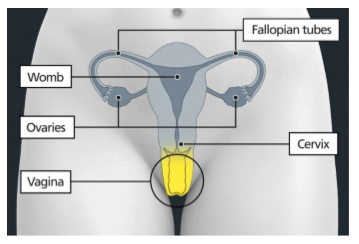Vaginal cancer occurs when abnormal cells in the vagina begin to grow and divide in an uncontrolled way. Vaginal cancer is a rare cancer and can be found anywhere in the vagina. It is more common for cancer to start in an area close by, such as cervix or womb (uterus), and grow into the vagina.
The vagina is a muscular tube between the vulva and the opening of the womb (cervix). It is also the passageway through which babies are born (the birth canal).

Vaginal cancer usually grows very slowly and is often found and prevented by attending cervical screening, which aims to identify abnormalities before they turn into cancer.
Common symptoms of vaginal cancer include:
- a lump in the vagina
- ulcers and other skin changes in or around the vagina
- bleeding between periods, after sex or after the menopause
- blood-stained vaginal discharge
- pain when passing urine, needing to pee often, or blood in your pee
- pain in the pelvic (lower tummy) area
The most common type of vaginal cancer is squamous cell carcinoma, which can take many years to develop. It starts in squamous cells that line the vagina, usually in the upper part of the vagina.
Rarer types of vaginal cancer include:
- adenocarcinoma
- melanoma
- small cell carcinoma
- sarcoma
Treatment for vaginal cancer at CUH
The treatment you have depends on several factors, which include:
- the type and size of the cancer
- the stage of the cancer
- your general health
- whether you want to get pregnant in future
A team of specialists at CUH will meet to discuss your condition and to make a recommendation about the best possible treatment for you.
You, along with your clinician, will then discuss your treatment recommendations at the clinic appointment and decide on the right treatment plan for you. Your clinician will explain the different treatments and their side effects.
The treatment for vaginal cancer can include:
- radiotherapy
- chemotherapy
- chemoradiation
- surgery
- clinical trials
At times, you may require more than one treatment or a combination of different treatments to give the best chance of long-term cure and to help reduce the risk of the cancer coming back.
Read more about the different types of treatment on our website.

